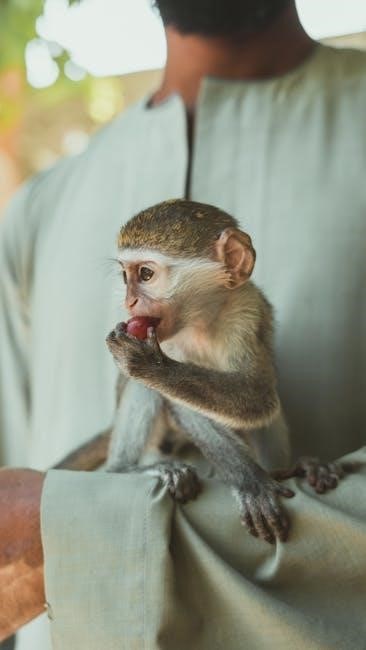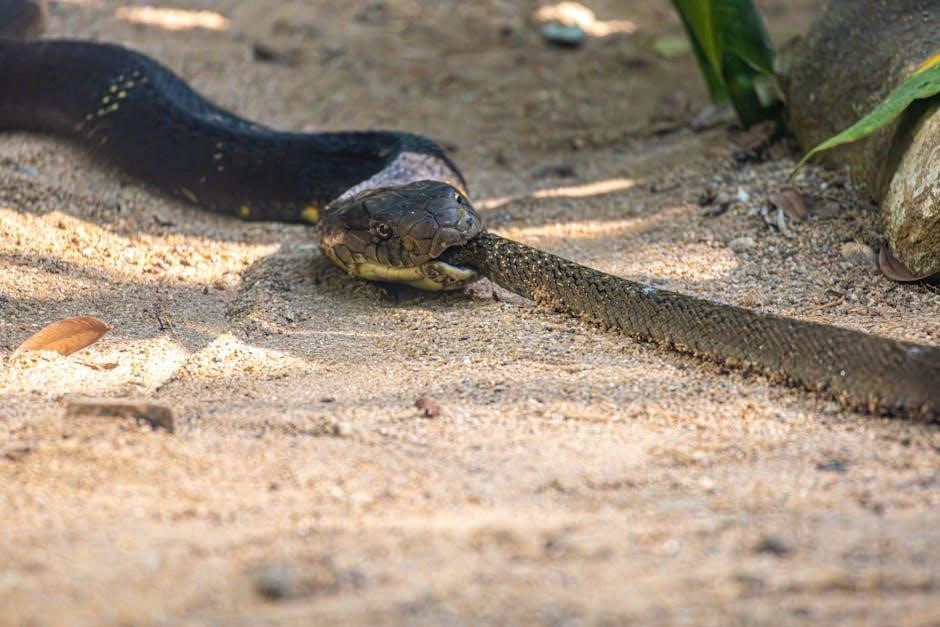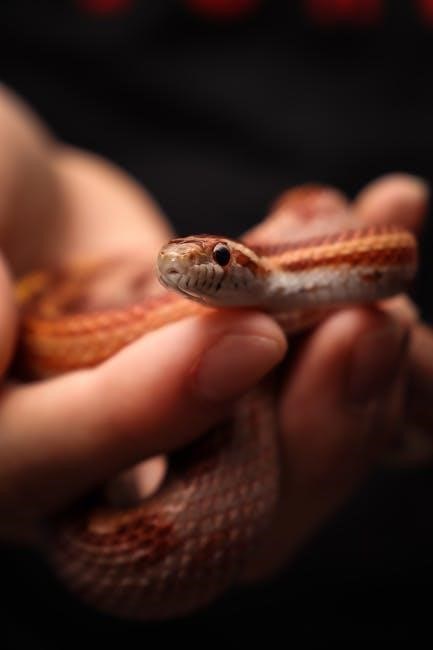corn snake feeding guide
Feeding corn snakes is a critical aspect of their care, ensuring proper growth and health. Their diet consists mainly of rodents, such as mice and rats, which provide essential nutrients. A well-structured feeding schedule, appropriate prey size, and diet variety are vital for their development. Corn snakes thrive on whole animal prey, starting with pinky mice for hatchlings and progressing to larger prey as they grow. Avoiding underfeeding or overfeeding is crucial to prevent malnutrition or obesity. Understanding their feeding needs is key to raising a healthy, thriving corn snake.
Understanding the Basics of Corn Snake Nutrition
Corn snakes are carnivores, requiring a diet rich in protein from whole animal prey like mice and rats. Their nutrition relies on consuming prey that provides essential vitamins and minerals for growth and health. The prey size should not exceed 1.5 times the snake’s mid-body width to ensure safe digestion. Feeding frequency varies with age, from weekly for juveniles to every 1-2 weeks for adults; A balanced diet prevents malnutrition and obesity, while avoiding wild prey reduces parasite risks. Proper nutrition supports shedding, energy, and overall well-being, making it a cornerstone of corn snake care.
The Importance of a Proper Feeding Schedule
A well-planned feeding schedule is essential for maintaining the health and vitality of corn snakes. Consistent feeding ensures steady growth, prevents underfeeding or overfeeding, and supports metabolic balance. Younger snakes, such as hatchlings, require more frequent meals to fuel rapid growth, while adults need less frequent feeding to maintain weight. A structured schedule also helps monitor digestion and reduces the risk of feeding-related issues. Adhering to a proper schedule ensures optimal nutrient absorption, supports shedding cycles, and contributes to a long, healthy life for your corn snake.

Corn Snake Feeding Guide by Age
Corn snakes’ dietary needs vary with age. Hatchlings start with pinky mice, juveniles progress to fuzzies, and adults eat larger prey like mice or rats, ensuring proper growth and health.
Hatchling Corn Snakes (0-6 Months)
Hatchling corn snakes require a diet of small prey, such as pinky mice, to support their rapid growth. Feed them every 5-7 days, ensuring prey size matches their girth. Offer multiple pinkies if needed. As they grow, gradually increase prey size to fuzzies. Avoid overfeeding; monitor weight and adjust portions. Provide fresh water daily and maintain proper humidity. A clean environment is crucial for digestion and health. Hatchlings may be more sensitive, so observe feeding behavior closely. Stick to captive-bred prey to minimize parasite risks. Consistency in feeding schedule and prey quality ensures strong, healthy development during this critical stage.
Juvenile Corn Snakes (6-12 Months)
Juvenile corn snakes (6-12 months) transition from pinkies to fuzzies and eventually hopper mice. Feed them every 7-10 days, as their growth slows slightly. Ensure prey size matches their mid-body girth, ideally 1-1.5x wider. Avoid feeding wild prey to prevent parasites. Monitor weight gain and adjust portion sizes to maintain a healthy growth rate. Provide fresh water daily and maintain proper humidity levels. Juveniles may be more active, so ensure they have space to move. Stick to a consistent feeding schedule and prey quality to support their development into strong, robust snakes.
Adult Corn Snakes (1+ Year)
Adult corn snakes (1+ year) typically feed on adult mice or rats, depending on their size. Feed every 10-14 days, as their metabolism slows with age. Prey should be no more than 1.5x the snake’s mid-body width. Avoid overfeeding to prevent obesity. Monitor weight and adjust portions if necessary. Provide fresh water daily to aid digestion. Adults may occasionally refuse food due to stress or health issues. Stick to pre-killed prey to minimize feeding stress. Maintain proper humidity and temperature for optimal health. A consistent feeding schedule ensures your adult corn snake remains thriving and robust.

Prey Size and Type Recommendations
Prey should be 1-1.5x the snake’s mid-body width, ensuring safe swallowing. Offer mice or rats, avoiding wild prey to prevent parasites. Defrost and warm prey before feeding.
Appropriate Prey Sizes for Corn Snakes
Prey size is crucial for corn snakes, ensuring safe digestion and proper nutrition. Hatchlings start with pinky mice, small enough for their developing mouths and digestive systems. As they grow, juveniles transition to fuzzy mice, and adults eat hopper or adult mice. The prey should not exceed 1.5 times the snake’s mid-body width. Proper sizing prevents regurgitation and health issues. Always defrost and warm prey to body temperature before feeding to mimic natural hunting conditions and stimulate the snake’s appetite. This approach ensures optimal growth and health throughout their life stages.
Types of Prey: Mice, Rats, and Other Options
Corn snakes primarily feed on mice and rats, which provide essential proteins and nutrients. Mice are ideal for younger snakes, while larger rats suit adult snakes. Other prey, such as quail eggs or chicks, can be offered occasionally but are not staples. Live prey is not recommended due to safety risks. Always use captive-bred prey to minimize parasite risks. This balanced approach ensures a nutritious diet tailored to the snake’s age, size, and dietary needs, promoting optimal health and growth.
Live vs. Pre-Killed Prey: Pros and Cons
Live prey stimulates a corn snake’s natural hunting instincts, promoting active foraging behavior. However, live prey can pose risks, as it may injure the snake if left unattended. Pre-killed prey is safer and more convenient, reducing the risk of injury and ensuring proper hygiene. Many snakes readily accept pre-killed prey, especially when warmed to mimic live prey’s warmth. However, some snakes may initially refuse pre-killed prey, requiring gradual introduction. Pre-killed options are generally recommended for ease, safety, and consistency in feeding, while live prey is better suited for experienced keepers or specific feeding situations.
Feeding Frequency and Schedule
Corn snakes require a feeding schedule tailored to their age and metabolism. Hatchlings are fed every 5-7 days, juveniles weekly, and adults every 1-2 weeks, adjusting as needed.
Feeding Frequency for Hatchlings
Hatchling corn snakes (0-6 months) require frequent feeding to support rapid growth. Feed pinky mice every 5-7 days, as their small size and high metabolism demand consistent nutrition. This schedule ensures proper development and prevents malnutrition. Monitor their weight and growth, adjusting the frequency slightly if needed. Overfeeding should be avoided to prevent obesity, while underfeeding can hinder growth. Stick to a routine, as hatchlings rely on regular meals to thrive during this critical phase of development. Always offer prey items appropriate for their age and size to promote healthy digestion and overall well-being.
Feeding Frequency for Juvenile Corn Snakes
Juvenile corn snakes (6-12 months) should be fed every 7-10 days, as their metabolism slows slightly compared to hatchlings. Offer fuzzies or small mice, progressing in size as they grow. This frequency supports steady growth without overloading their digestive system. Monitor their weight and adjust the schedule if necessary. Avoid overfeeding, as it can lead to obesity. Underfeeding is also a risk, so ensure they receive adequate nutrition for optimal health. Consistency is key during this stage to promote proper development and maintain a healthy appetite. Adjustments may be needed based on individual growth rates and activity levels.
Feeding Frequency for Adult Corn Snakes
Adult corn snakes typically require feeding every 10-14 days, with some individuals needing food as infrequently as every 21 days. Their metabolism slows significantly compared to younger snakes, so overfeeding should be avoided; Offer prey such as adult mice or rats, ensuring the size is appropriate—no more than 1.5 times the snake’s mid-body width. Feeding frequency can vary slightly based on the snake’s size, metabolism, and activity level. Overfeeding can lead to obesity, so monitoring weight and adjusting the schedule is essential. This balanced approach ensures optimal health and prevents potential digestive issues.
Diet Variety and Supplements
Corn snakes benefit from a varied diet of rodents, including mice, rats, and occasional alternatives like quail or chicks, to ensure nutritional diversity. Vitamins and mineral supplements can enhance their diet, though they are not always necessary if prey items are nutrient-rich. Moderation is key to avoiding over-supplementation, which can harm their health. A balanced diet supports optimal growth and long-term well-being in pet corn snakes, ensuring they thrive in captivity.
Introducing Variety in Your Corn Snake’s Diet
Introducing variety in your corn snake’s diet is essential to ensure they receive a broad spectrum of nutrients. While mice and rats are staples, offering occasional alternatives like quail, chicks, or gerbil pups can provide diversity. Hatchlings typically start with pinky mice, gradually transitioning to fuzzies and hopper mice as they grow. Juvenile and adult snakes can be introduced to larger prey items or different rodent species to prevent them from becoming picky eaters. However, avoid feeding wild animals due to the risk of parasites. A varied diet helps maintain their interest in feeding and supports overall health and development.
The Role of Vitamins and Mineral Supplements
Vitamins and mineral supplements play a crucial role in ensuring your corn snake’s optimal health. While whole prey items provide essential nutrients, occasional supplementation can help fill dietary gaps. Calcium is vital for bone development, especially in growing snakes, while vitamin D3 supports calcium absorption. A balanced reptile-specific supplement can be lightly dusted on prey items during feeding. However, over-supplementation should be avoided to prevent metabolic issues. Always follow the manufacturer’s instructions and consult a veterinarian for tailored advice, ensuring your corn snake receives a well-rounded and nutritionally complete diet throughout its life.
Factors Affecting Feeding Needs
Snake size, metabolism, activity level, and health conditions influence feeding requirements. Larger snakes need more food, while inactive or ill snakes may require adjustments to their diet.
Snake Size and Metabolism
A corn snake’s size and metabolism significantly influence its feeding needs. Larger snakes require bigger prey items, while smaller snakes need appropriately sized meals to prevent health issues. Metabolism plays a key role in determining feeding frequency, with younger, faster-growing snakes needing more frequent meals compared to adults. As snakes grow, their metabolic rate slows, reducing the need for constant feeding. Ensuring the right balance between prey size and feeding frequency is essential to support healthy growth and maintain optimal weight, avoiding both malnutrition and obesity.
Activity Level and Growth Rate
A corn snake’s activity level and growth rate are critical factors in determining its feeding needs. Actively growing snakes, particularly hatchlings and juveniles, require more frequent meals to support their rapid development. Snakes with higher activity levels may need slightly larger or more frequent prey items to maintain energy reserves. Conversely, snakes with slower growth rates or lower activity may require adjustments to prevent overfeeding. Monitoring growth and activity ensures that feeding schedules align with the snake’s energy expenditure and developmental needs, promoting healthy weight and overall well-being.
Health Conditions and Feeding Adjustments
Certain health conditions may necessitate adjustments to a corn snake’s feeding regimen. Snakes with digestive issues or parasites may require temporary fasting or smaller, more frequent meals to aid recovery. Overweight snakes might need portion-controlled or less frequent feedings to manage weight. Conversely, underweight snakes may require more nutrient-dense prey or increased feeding frequency. Consulting a veterinarian is essential for tailored advice, as specific health issues can significantly impact feeding strategies. Adjustments should always prioritize the snake’s overall health and well-being, ensuring optimal nutrition without exacerbating existing conditions.

Common Feeding Challenges
Corn snakes may face feeding challenges like refusal to eat, overfeeding, or underfeeding. These issues can stem from improper prey size, health problems, or environmental stress, requiring careful correction to ensure optimal health and growth.
Feeding Strikes and Refusal
Feeding strikes in corn snakes can occur due to stress, environmental changes, or health issues. refusal to eat is often temporary but may require veterinary attention if persistent. ensure proper temperature and humidity levels, as these factors significantly impact appetite. offering prey items of varying sizes or types, such as fuzzies or hopper mice, can sometimes entice a reluctant eater. live prey may also stimulate feeding behavior in snakes that refuse pre-killed food. consistently monitor your snake’s behavior and adjust feeding strategies as needed to prevent malnutrition and maintain overall health.
Overfeeding and Obesity
Overfeeding can lead to obesity in corn snakes, causing health issues like reduced mobility and organ strain. Avoid feeding too frequently or offering prey too large for the snake’s size. Monitor weight and growth to prevent overfeeding. Stick to a feeding schedule based on age and size, ensuring prey does not exceed 1.5 times the snake’s mid-body width. Remove uneaten prey promptly and avoid feeding during shedding or stress. Regular weighing and observing feeding behavior can help detect early signs of obesity, allowing for timely adjustments to maintain a healthy weight and overall well-being.
Underfeeding and Malnutrition
Underfeeding can lead to malnutrition, stunted growth, and weakened immunity in corn snakes. Inadequate prey size or frequency results in insufficient nutrients, affecting overall health. Signs include lethargy, poor shedding, and lack of weight gain. Ensure a balanced diet with appropriate prey sizes and feeding schedules tailored to the snake’s age and size. Regularly monitor growth and adjust feeding plans to prevent malnutrition. Avoid skipping meals or offering prey that is too small, as this can hinder proper development. Consistent, nutrient-rich meals are essential for maintaining a corn snake’s optimal health and vitality.

Troubleshooting Feeding Issues
Identify feeding problems early, such as refusal or regurgitation. Adjust prey size, type, or presentation. Monitor health signs like lethargy or poor shedding. Consult a vet if issues persist.
Identifying and Addressing Feeding Problems
Identifying feeding issues in corn snakes requires close observation of their behavior and physical condition. Common problems include feeding strikes, where the snake refuses prey, or regurgitation, which can indicate stress or improper prey size. Monitoring for signs like lethargy, weight loss, or poor shedding is crucial. Addressing these issues may involve adjusting the prey size or type, ensuring proper temperature levels, or varying feeding techniques. If problems persist, consulting a veterinarian experienced in reptile care is essential to rule out underlying health conditions and provide tailored solutions for your corn snake.
Consulting a Veterinarian for Feeding Advice
Consulting a veterinarian experienced in reptile care is crucial for personalized feeding advice tailored to your corn snake’s specific needs. They can assess your snake’s health, growth rate, and feeding response to recommend optimal prey sizes and frequencies. Veterinarians can also address feeding challenges, such as refusal or regurgitation, by identifying underlying issues like parasites or metabolic problems. Regular check-ups ensure your corn snake receives a balanced diet, promoting long-term health and preventing nutrition-related disorders. Their expertise provides peace of mind and helps maintain your pet’s well-being throughout its life.

Monitoring and Adjusting the Feeding Plan
Monitor your corn snake’s growth, weight, and shedding cycles to assess feeding effectiveness. Adjust prey size and frequency based on growth rate and health indicators like skin condition and energy levels.
Tracking Growth and Health
Regularly track your corn snake’s growth by measuring its weight and length. Monitor shedding cycles, as frequent sheds indicate healthy growth. Observe overall appearance, ensuring the snake is active and has a robust physique. Check for signs of proper digestion, such as regular bowel movements. Adjust feeding schedules if growth slows or if the snake appears underweight. A logbook can help document progress, ensuring any deviations from expected growth patterns are addressed promptly. This proactive approach ensures optimal health and development throughout your corn snake’s life.
Adjusting Prey Size and Frequency as Needed
Adjusting prey size and feeding frequency ensures your corn snake’s nutritional needs are met as it grows. Prey should be 1-1.5x the snake’s mid-body width. Hatchlings start with pinkies, progressing to fuzzies, then small mice. Adults typically eat larger mice or rats. Feeding frequency varies with age: hatchlings may eat every 5-7 days, juveniles every 7-10 days, and adults every 10-14 days. Monitor weight and adjust portions to avoid obesity. Growth spurts may require larger prey or more frequent meals. Always assess your snake’s condition and adjust feeding strategies to maintain optimal health and steady growth.
Expert Recommendations and Tips
Experienced breeders emphasize using high-quality, pre-killed prey and maintaining a consistent feeding schedule. Consult a veterinarian for personalized advice and ensure prey is appropriately sized for optimal health.
Best Practices from Experienced Breeders
Experienced breeders recommend adhering to a well-structured feeding chart tailored to your corn snake’s age and size. Pre-killed prey is preferred for convenience and reduced risk of injury. Ensure prey items are no more than 1.5 times the snake’s mid-body width to prevent digestive issues. Avoid wild-caught prey to minimize parasite risks. Feeding frequency should align with growth stages, transitioning from weekly for juveniles to bi-weekly for adults. Monitor shedding cycles and adjust feeding schedules accordingly. Consistency and attention to individual needs are key to raising healthy, thriving corn snakes.
Advanced Feeding Strategies for Optimal Health
Advanced feeding strategies involve diversifying your corn snake’s diet with occasional offerings like quail or hopper mice to stimulate natural foraging instincts. Rotate prey types to ensure a broad nutrient profile and prevent boredom. Consider adding calcium or vitamin supplements every 4-6 feedings, especially for growing juveniles. Pre-killed prey is recommended to reduce injury risks. Maintain a consistent feeding schedule, such as once a week for adults, to establish a routine. Always provide a shallow water dish for hydration. Monitor growth through shedding cycles and adjust prey size as needed. This approach ensures long-term health and vitality for your corn snake.
A well-structured feeding plan, tailored to age and size, ensures optimal health for corn snakes. Regularly monitor growth and adjust prey size and frequency as needed.
Long-Term Feeding Strategies for Your Corn Snake
For long-term health, establish a consistent feeding schedule tailored to your corn snake’s age and size. Hatchlings may need more frequent meals, while adults can thrive on less frequent feedings. Ensure prey size aligns with your snake’s girth, avoiding items too large or small. Introduce variety in prey types to provide a balanced diet. Monitor your snake’s weight and growth, adjusting feeding frequency as needed to prevent obesity or malnutrition. Regular veterinary check-ups can help maintain your corn snake’s optimal health and address any feeding concerns early on;
Staying Informed About Feeding Guidelines
Staying informed about feeding guidelines is essential for ensuring your corn snake’s health and well-being. Consult reputable sources, such as veterinary recommendations, breeding guides, and trusted reptile care websites. Feeding practices may evolve as new research emerges, so regularly updating your knowledge is crucial. Join reptile care forums or groups to connect with experienced breeders and enthusiasts who share insights and tips. Always verify information through multiple sources to ensure accuracy. By staying informed, you can adapt your feeding strategies to meet your corn snake’s specific needs and promote long-term health.


